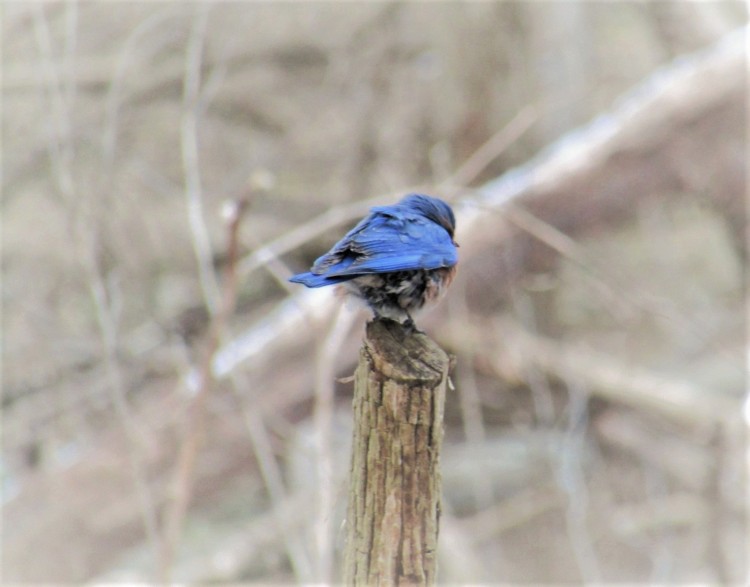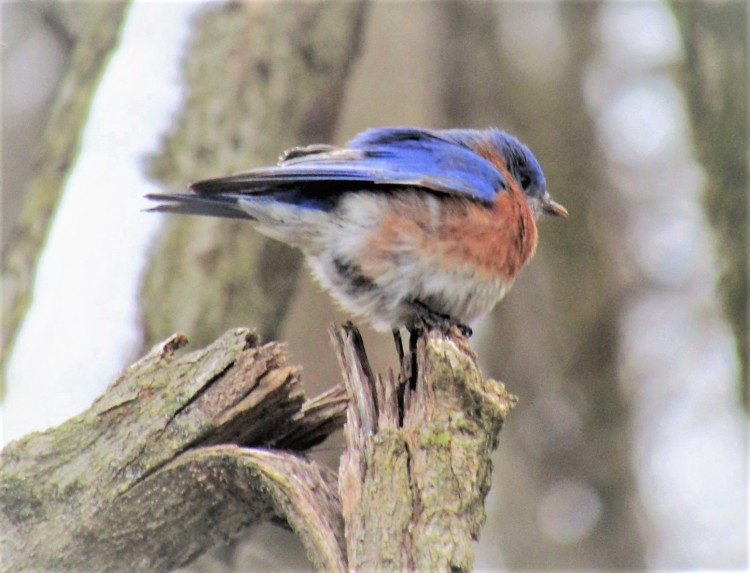
Growing up as a city kid in the ’60’s, bluebirds seemed like faraway mythical creatures. I’d never actually seen one, but read that people built special trails for them with boxes to nest in. Once while hiking we came across just such a box mounted on a fence post -but alas, no bluebirds. Years later, living on the west coast, I came to know both western and mountain bluebirds and to recognize their calls. So when I finally heard that distinctive little “cheery-we” call in this forest, I knew Eastern bluebirds were about.

Eastern bluebird populations were likely at their lowest ebb during my childhood, due to the unfortunate convergance of DDT, fire suppression, House sparrows, Starlings, habitat loss, severe winters, and chainsaws (more snags removed). But fortunately for the well-loved bluebird, its decline was noticed. The single most important action in its recovery (besides banning agricultural DDT use), was one taken by ordinary people – the creation of nestbox “bluebird trails”. The idea that anyone could pitch in to help a species in trouble was somewhat new, but the plight of the bluebird captured the public imagination.
Close to home, blue bird conservationists William and Azalea Duncan wrote a newsletter, set up numerous bluebird trails in Jefferson County, KY and developed the “Duncan” nest box with a round hole an inch and a half in diameter.
The nestbox campaign paid off, and sixty years later bluebirds are thriving again. Their population is estimated to be about 20 million and increasing. Which is likely why foraging flocks now drift through our little fragment every winter.

But another reason they keep coming is the habitat – apparently we’ve created excellent bluebird winter foraging grounds. Little did I know, when years ago we began to cut Bush honeysuckle shrubs at a height of 4 or 5 feet, that one day they would be bluebird perches! Woods that were overwhelmed by these giant spreading shrubs are now a sea of stumps.

Sitting quietly on a stump or low perch, bluebirds scan the ground for minute movement in the leaf litter, then swoop down to snatch their prey. Even in winter these moist bottomland soils are rich in sowbugs, snails, centipedes, insect larvae, spiders, etc. – all on the bluebird menu. They don’t go for earthworms like their robin cousins, unless nothing else can be found. Though berries are an important fall and winter food, there don’t seem to be any left in this forest, so their gleanings must be entirely of the arthropod sort.

The bluebird flocks I’ve observed this winter were foraging most actively just around dusk. Last week I followed a small band as they drifted through the understory, mostly ignoring my presence. It was a thrill to be so close, but waning light and numb fingers made it hard to hold the camera steady.

Lacking a handy perch, the bluebirds clung to the sides of trees while scanning for food. I couldn’t get an image of one actually on the ground, since their habit seems to be grab and go.

Bluebirds look very different from other thrushes – as they evolved to become open country birds, the dull browns of their forest dwelling clan were exchanged for hues that mirror the sky. It feels odd to see them in a forest, their bright blues the only spark of color among the winter-grey trees.

Will some of them stick around to nest? There is potential breeding habitat on the edges of the forest, but also plenty of competition from woodpeckers, House sparrows, Starlings, and House wrens. Despite the increasing number of dead trees, nesting cavities are at a premium since only woodpeckers can make them. Though historically bluebirds nested entirely in cavities, times have changed and most of the population relies on nest boxes. After last week’s bluebird sighting, I bought a few handmade cedar boxes, and will try to get them up soon. It may be a longshot, but wouldn’t it be great to see bluebirds nesting in urban Lousiville?
If you have nesting bluebirds on your property, please share your experience. I’d love to learn more about their habitat needs.

Elizabeth
Thanks, Rosemary. I am thrilled that bluebirds are in our forest! I have never seen one, so maybe I’ll get lucky. Great Blog and pictures as usual!
LikeLiked by 1 person
oneforestfragment
thanks Elizabeth – though they seem to wander through, it’s a regular thing now!
LikeLike
Jane Halliday
If you get a design for the bluebird boxes or know of a place to buy them, please share!
LikeLiked by 1 person
oneforestfragment
I bought them on ebay from someone in Wisconsin – depending on how many you get, price is $10-20@. They need to be placed in or on the edge of a large open area, at about 5 foot height. It’s believed they should face east, not sure if this is a verified fact!
LikeLike
Anonymous
Love your info on bluebirds, my favorite! We have several bluebirds on our property and a nesting box in our backyard. They started visiting the box in February and are now building their nest. To help them out this past winter we put an upside down bucket neat the box and put meal worms on top. They love meal worms. We have even gotten them to come closer to the house by putting meal worms on a tray on the ground and gradually moving it closer to the deck. They are amazing to watch.
LikeLiked by 1 person
oneforestfragment
That’s great! Did they stay through the winter?
LikeLike
shoreacres
The boxes not only need to be in an open area, there needs to be a substantial, clear path into the box. I’m not sure how long that “flight path” needs to be, but when my aunt increased its length from about 10′ to about 30′, some bluebirds moved right in.
I’ve never seen one except at a distance, in her backyard. They certainly shine in your woods!
LikeLiked by 1 person
oneforestfragment
That is really good info, thanks for sharing! We’re planning to put up some boxes tomorrow in grassy areas on the forest edge.
LikeLiked by 1 person
Lynn A Westberg
Could you post a picture of the nesting boxes or explain. Not sure what that is. Love all your posts. I have a couple of big blue jays coming around my yard.
LikeLiked by 1 person
oneforestfragment
Thank-you! Just go to ebay and search “bluebird nest box”. There are many people making them and selling on the site. I just bought some basic ones make of cedar, you can pay a lot or a little, depending on what you want. Also, google the topic of nest boxes, there is wealth of info online about types of boxes, habitat, placement, etc.
LikeLike
tonytomeo
You know, I have never seen one of these before. They do not live here. When I was a kid, cardinals were mythical creatures. They still seem strange to me. I can not imagine whey a birds would be so red. I saw one and only one in Oklahoma in about December of 2012.
LikeLiked by 1 person
oneforestfragment
You may have Western bluebirds, they are a bit darker blue than the eastern ones. I never get tired of seeing cardinals, even though they are all over the place here!
LikeLiked by 1 person
tonytomeo
The only bluebirds here are the various jays, and they are nasty. If I remember, there is a bluebird that lives in the Sierra Nevada, but I would not know it if I saw it.
LikeLiked by 1 person
oneforestfragment
That would be the Mountain bluebird, it’s the prettiest shade of blue I’ve ever seen!
LikeLiked by 1 person
tonytomeo
Yes, I many not know it, but I would probably be impressed by the color, and not forget it.
LikeLike
shoreacres
Our high school teams in Iowa were the Cardinals. I once built a snow cardinal in our front yard, packing snow around a piece of plywood for its tail!
LikeLiked by 2 people
oneforestfragment
Hope your teams were as successful as the Northern cardinal! Its range has expanded greatly in the 20th century due to urbanization, bird feeding, milder winters, and let’s admit it – invasive species, especially Bush Honeysuckle! -Right now in the forest they seem to be everywhere, sparring over the choice nesting sites.
LikeLiked by 1 person
Jim Sky
As I mentioned on your coyote post- lecture walk, i saw my first bluebird just recently in Iroquois Park. I am almost embarrassed that I am 66 and just now spotted one (I am new to birding but not the Earth). Bluebirds appear as common backyard species in almost every beginners bird book so I have been looking. Now for the apparently (to everyone but me) ubiquitous Cedar Waxwing.
Re. the Northern Cardinals, we are currently at our little cabin on the Big Island of Hawaii for a couple of weeks. We are in the upland Ohia forest at about 3300 ft elevation. The Cardinal is probably the most often heard bird here! The calls are similar but not the same as they are in KY. Its the first call you hear in the morning and the last you hear at night. I only see a couple of bird species native to Hawaii in the woods where we live. The Apapane, and an occasional Hawaiian Hawk. The Cardinal seems like an aggressive bird to me, and while I love them in KY, I wish people wouldn’t introduce them where they are not native.
LikeLiked by 1 person
oneforestfragment
I have heard the Hawaiian islands are full of introduced species, but didn’t know about the Northern cardinal! Interesting that their calls are a little different – these isolated species will diverge over time and eventually may even become subspecies or new species. It was good to meet you at the talk!
LikeLike
oneforestfragment
I usually only know Cedar waxwings are around when I hear their distinctive high-pitched whistling. Outside of breeding season the flocks move around a lot in search of berries.
LikeLike
Louisville ECHO
Great stuff, Rosemary! Here is some info on building and/or placing nest boxes:
https://nestwatch.org/learn/all-about-birdhouses/birds/eastern-bluebird/?__hstc=75100365.935d916325a6e3bb02781e8434ca0e37.1553004044520.1553004044520.1553004044520.1&__hssc=75100365.2.1553004044522&__hsfp=2021768341#_ga=2.87073240.1389172961.1553004041-1985511528.1553004041
LikeLiked by 1 person
oneforestfragment
Thanks Ginnie!
LikeLike